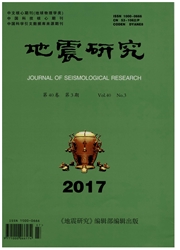

 中文摘要:
中文摘要:
通过设定一定的标准,对1730年发生在北京西郊61/2级地震的破坏记录进行数字化,得到地震在地表造成的实际破坏的定量分布图像;使用有限差分方法,计算出两条可能的发震断层——NE向的清河隐伏断层和NW向的东北旺-小汤山断裂在滑动角为0°和90°时,在地表产生的加速度的分布。通过将峰值加速度分布图像与实际破坏程度定量分布图像进行拟合,推算出了两条可能发震断层在这次地震中的作用(权重)及滑动角,从而判断出此次地震的主要发震断层是东北旺-小汤山断裂。为增加结果的可信度,文中还讨论了不同的地表破坏程度数据化模型对拟合结果的影响。
 英文摘要:
英文摘要:
In 1730 AD, an earthquake with magnitude 6 1/2 occurred in the western suburb of Beijing. The then government of Qing Dynasty dispatched persons to investigate and record the damages in Beijing and surroundings caused by the earthquake. In this paper, through setting up some standards, we quantify the damage records of the earthquake and obtain the distribution of the damage intensity. We use finite-difference method to calculate the ground accelerations caused by two possible seismogenic faults (NE-trend Qinghe concealed fault and NW- trend Dongbeiwang-Xiaotangshan fault) for the given rake angle of 0° and 90°. By comparing and fitting the spatial distribution of the calculated peak ground acceleration with that of the damage intensity obtained from the historical records, we estimate the relative contribution of the two faults and their rake angles, and refer that the main seismogenic fault is the Dongbeiwang-Xiaotangshan fault. Since the results may be dependent on the models applied to quantifying the damage records, we experiment with different models to assess their effect on the results.
 同期刊论文项目
同期刊论文项目
 同项目期刊论文
同项目期刊论文
 期刊信息
期刊信息
